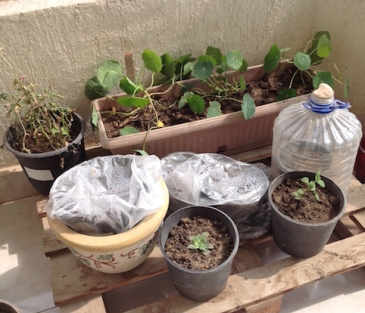Turning the GM tide
Or: Just a few drops in the ocean…
The day I published my last post an email came into the inbox from Charles Dowding , the no-dig guru in Somerset, UK, (see: https://charlesdowding.co.uk) with an update on crops best started off in warm conditions “undercover” – on a windowsill, in a heated glasshouse or poly-tunnel at this time of year.
New sowings need warmth up to 25C/77F, if they are to “break their dormancy,” he writes.
So I guess the haphazard little hothouses I rigged up on the sunny top balcony are just the kind of thing our seeds need:

Here, I have used a plastic bag, cut open and spread out to cover several small pots. Also, an old mineral water container with the bottom cut out and the top left on (assuming I haven’t lost the lid!), which seems a much better use for it than throwing it in the rubbish bin.
In fact, I think water bottles are often re-used in Egypt, and I should add that we usually filter our domestic water rather than relying on the bottled stuff. Most of the latter is supplied by major multinationals such as Pepsi and Nestle – companies that must be laughing all the way to the bank at our expense. On principle, I prefer to avoid their products whenever I can.
I haven’t, however, followed Dowding’s advice on multi-sowing of seeds. Placing several seeds in one cell, module or pot is comforting for them, he suggests: They “enjoy each other’s company.” I’ve noticed it’s standard practice among farmers in Egypt, as my gardeners usually plant seeds and seedlings (courgettes, peppers, aubergines for example) in twos. Dowding suggests 4-5 beetroots and onions, 6-8 spring onions, 2-4 spinach, 3-4 radishes. This technique presumably helps solve the problem of erratic germination too.
As he says you can transplant them in clumps, I guess the practice is to thin them out as they grow taller, particularly important for root crops.
The pots in the picture above all contain courgettes or zucchini (one seed per pot, with three in the slightly bigger pot at the back). They are heritage Verde di Italia seeds. As you may recall, ever since I discovered that an Engineer/gardener last year planted seeds from the Monsanto-owned Seminis company I have taken care to keep more control of the seeds we use.
Reading more about the subject of GM foods, I was disturbed to find that, among veg, courgettes and squash are very likely to be GM varieties. Most to be avoided, owing to the ubiquity of GM seeds, are corn and sugar beet and their derivatives – which means an awful lot of processed foods are out of bounds. I am not suggesting that you mustn’t consume GM foods, but I have made the decision that I do not wish to. And I would like to have sufficient information about where our food comes from to be able to make informed decisions.
This, currently, is not the case in Egypt. Crops may be packaged as “organic” with a whole array of certification stamps, and we have several companies that now market organic produce, but I don’t see any guarantee that they are not GM.
There is another, economic argument to be made: GM seeds are very costly. Not so the heritage varieties, assuming you save your own seeds.
Also on the balcony: several pots of babies from all around the garden. These are self-seeded little chaps, which I collect up every so often if I can think of a better place for them:

In the pots are (from left to right and from back to front): struggling convolvulus, planted from seed, that I neglected to water; nasturtiums extracted from a raised bed; aeonium rescued from a border after being knocked off the mother plant, probably by our dog; and marjoram or oregano found in another raised bed. The undercover pots are still to be planted, as I am warming the soil ahead of sowing tomatoes.
I have no idea if my tiny plot tucked away in an obscure corner of New Cairo can in any way turn the tide against GM. I doubt it. What will probably happen is a major disaster in the environment, to do with our precious pollinators, or affecting long-term damage to human health… by which time, the genie will be well and truly out of the bottle.
